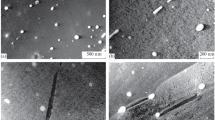The effect of the stress distribution on the hydride distribution in zirconium cladding of fuel elements with dispersion fuel is analyzed. It is shown that reorientation of zirconium hydrides can occur in fuel-element cladding under the action of tensile stresses, which can result in the appearance of radially oriented hydrides and plasticity reduction in the cladding upon cool-down of the fuel elements. The threshold tensile stresses are determined in the cladding in the unirradiated and irradiated states, in which hydride reorientation from tangential to radial occurs.
Similar content being viewed by others
References
O. B. Samoilov, D. G. Preobrazhenskii, O. A. Morozov, et al., “Results of operation and conditions of operation of icebreaker cores,” in: Abstr. 8th Russ. Conf. on Reactor Materials Engineering, NIIAR, Dimitrovgrad, Sept. 14, 2009, pp. 68–90.
A. V. Vatulin, I. N. Volkova, and A. E. Novoselov, “Corrosion of the alloy E-635 in the core of a nuclear icebreaker,” At. Energy, 111, No. 235–237 (2011).
G. V. Kulakov, A. V. Vatulin, S. A. Ershov, et al., “R&D problems of securing fuel-element life in floating NPP core with extended power-generation life,” Vopr. At. Nauki Tekhn. Ser. Materialoved. Nov. Mater., No. 1(74), 91–103 (2013).
K. Lee and S. Hong, “Zirconium hydrides and their effect on the circumferential mechanical properties of Zr–Sn–Fe–Nb tubes,” J. Alloy Comp., 346, No. 1–2, 302–307 (2002).
S. Min, M. Kim, and K. Kim, “Cooling rate-and hydrogen content-dependent hydride reorientation and mechanical property degradation of Zr–Nb alloy claddings,” J. Nucl. Mater., 441, 306–314 (2013).
A. V. Nikulina, “Zirconium alloys in nuclear power,” Metalloved. Term. Obrab. Met., No. 11, 8–12 (2004).
K. Une and S. Ishimoto, “Dissolution and precipitation behavior of hydrides in zircaloy-2 and high Fe zircaloy,” J. Nucl. Sci., 322, 66–72 (2003).
K. Colas, A. Motta, J. Almer, et al., “In situ study of hydride precipitation kinetics and reorientation in zircaloy using synchrotron radiation,” Acta Mater., 58, 6575–6583 (2010).
R. Singh, R. Kishore, S. Singh, et al., “Stress-reorientation of hydrides and hydride embrittlement of Zr–2.5 wt.% Nb pressure tube alloy,” J. Nucl. Mater., 325, 26–33 (2004).
Yu. V. Konovalov, G. V. Kulakov, A. V. Vatulin, et al. “Development of a database on the results of post-reactor studies and on properties of dispersion-type fuel elements,” Vopr. At. Nauki Tekhn. Ser. Materialoved. Nov. Mater., No. 1(74), 17–2 5 (2013).
Author information
Authors and Affiliations
Additional information
Translated from Atomnaya Énergiya, Vol. 122, No. 2, pp. 73–77, February, 2017.
Rights and permissions
About this article
Cite this article
Kulakov, G.V., Vatulin, A.V., Konovalov, Y.V. et al. Analysis of the Effect of the Stress-Strain State of Irradiated Zirconium-Alloy Fuel-Element Cladding on Hydride Orientation . At Energy 122, 87–92 (2017). https://doi.org/10.1007/s10512-017-0240-1
Received:
Published:
Issue Date:
DOI: https://doi.org/10.1007/s10512-017-0240-1




